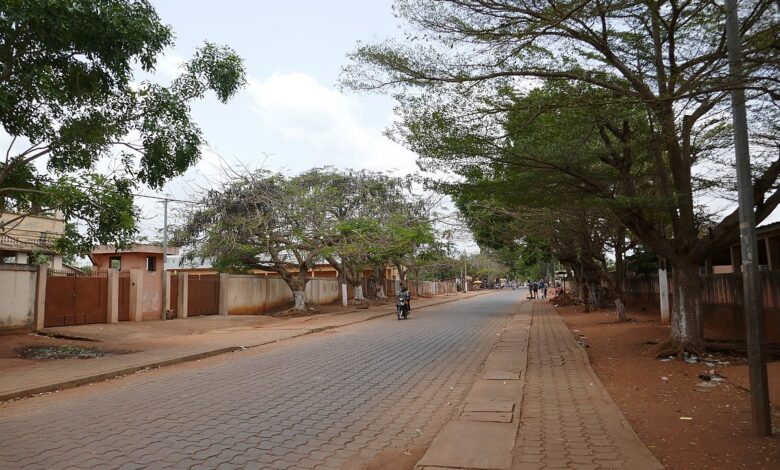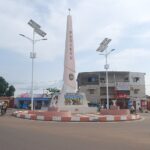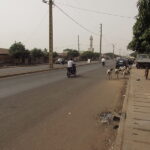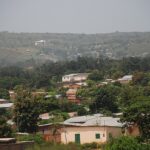Abomey

In the southern expanse of Benin lies the town of Abomey, strategically positioned approximately 60 miles (100 km) to the north of Cotonou.
Presumed to have its genesis in the early 17th century, Abomey swiftly ascended to prominence as the epicentre of the Abomey Kingdom, later known as Dahomey. This nomenclature characterized the nation until the conclusion of the 19th century. This dominion wielded considerable influence over production and trade, engaging in commerce with European entities along the Slave Coast. Abomey’s terrain is adorned with palm nuts and groundnut cultivation, interconnected by road and rail to Cotonou, the principal commercial hub, and Porto-Novo, the esteemed capital.
Within the confines of Abomey, the vestiges of regal palaces, the graves of monarchs, and an archival museum endure. Acknowledging its cultural significance, the royal palaces secured the esteemed title of a UNESCO World Heritage site in 1985. The town’s economic landscape bears the imprint of tourism, a pivotal contributor to its prosperity.
Map view
More about Abomey from Wikipedia
| ID |
|---|
| 9779 |
| Name |
| Abomey |
| State ID |
| 3073 |
| State Code |
| ZO |
| State Name |
| Zou Department |
| Country ID |
| 24 |
| Country Code |
| BJ |
| Country Name |
| Benin |
| Latitude |
| 7.18286000 |
| Longitude |
| 1.99119000 |
| WikiData ID |
| Q189685 |
Agbome or Abomey [a.bɔ.mɛ] is the capital of the Zou Department of Benin. The commune of Abomey covers an area of 142 square kilometres and, as of 2012, had a population of 90,195 people.
Abomey houses the Royal Palaces of Abomey, a collection of small traditional houses that were inhabited by the Kings of Dahomey from 1600 to 1900, and which were designated a World Heritage Site by UNESCO in 1985.
History
Abomey was founded in the 17th century as the capital of the Kingdom of Dahomey (1600–1904), on the site of the former village of Kana. Traditional legends state that the town was founded by Do-Aklin, a son of the king of Allada who ventured north to found his own kingdom; the name is thought to come from Danhomé, also spelled Danxomé, meaning "belly of Dan", Dan being the original chief of the village.
Dahomey expanded rapidly in the 1700s, absorbing many of the surrounding kingdoms, and growing rich from the slave trade. In the late 18th century, Abomey was surrounded only by dry ditch which was crossed by bridges that were protected by a garrison. The royal palaces were fortified with a nearly square mudbrick wall that was 20 feet high. The flanks reached almost 1 mile as blockhouses were built on each wall. By the 1840s it had an estimated population of 24,000.
After several attempts, the French conquered the kingdom on 16 November 1892, prompting King Béhanzin to torch the city and flee northward. Thereafter the town declined in importance, a process hastened when the French built the new administrative centre of Bohicon immediately to the east. Today, the city is of less importance, but is still popular with tourists and as a centre for crafts. Since 1985, Abomey has maintained its complex of royal palaces as a UNESCO World Heritage Site.
The Royal Palaces of Abomey
The Royal Palaces of Abomey are a group of earthen structures built by the Fon people between the mid-17th and late 19th Centuries. One of the most famous and historically significant traditional sites in West Africa, the palaces form a UNESCO World Heritage Sites.
During the reign of Béhanzin, the palaces covered some 44ha and it was surrounded by a 10 meter high wall reaching 4 km in length. Only 2 of the original 12 palace survived the 1892 burning by Béhanzin, Dahomey's last king. The French colonial administration rebuilt the town and connected it with the coast by a railroad.
When UNESCO designated the royal palaces of Abomey as a World Heritage Site in 1985 it stated:
- From 1625 to 1900 twelve kings succeeded one another at the head of the powerful Kingdom of Abomey. With the exception of King Akaba, who used a separate enclosure, they each had their palaces built within the same cob-wall area, in keeping with previous palaces as regards the use of space and materials. The royal palaces of Abomey are a unique reminder of this vanished kingdom.
From 1993, 50 of the 56 bas-reliefs that formerly decorated the walls of King Glèlè (now termed the "Salle des Bijoux") have been located and replaced on the rebuilt structure. The bas-reliefs carry an iconographic program expressing the history and power of the Fon people.
Threats
As reported by UNESCO, on 21 January 2009 the Royal Palaces of Abomey suffered from a fire "which destroyed several buildings." The fire was the most recent disaster to have plagued the site, coming after a powerful tornado damaged the site in 1984.
Demographics
Gallery
See also
- The city is twinned with Albi, France.
References
External links
- UNESCO assessment of threats to the site, after tornado damage in 1984.
- Historical Museum of Abomey Archived 2012-06-12 at the Wayback Machine
References
- http://world-gazetteer.com/wg.php?x=&men=gpro&lng=en&des=wg&geo=-35&srt=npan&col=abcdefghinoq&msz=1500&pt=c&va=&geo=346914209
- http://www.epa-prema.net/abomeyGB/index.html
- http://atlasbenin.africa-web.org/Zou/Abomey.htm
- http://www.statoids.com/ybj.html
- https://web.archive.org/web/20100102050757/http://statoids.com/ybj.html
- https://viaf.org/viaf/148927559
- https://d-nb.info/gnd/4079610-3
- https://catalogue.bnf.fr/ark:/12148/cb124100470
- https://data.bnf.fr/ark:/12148/cb124100470
- https://whc.unesco.org/en/news/488




